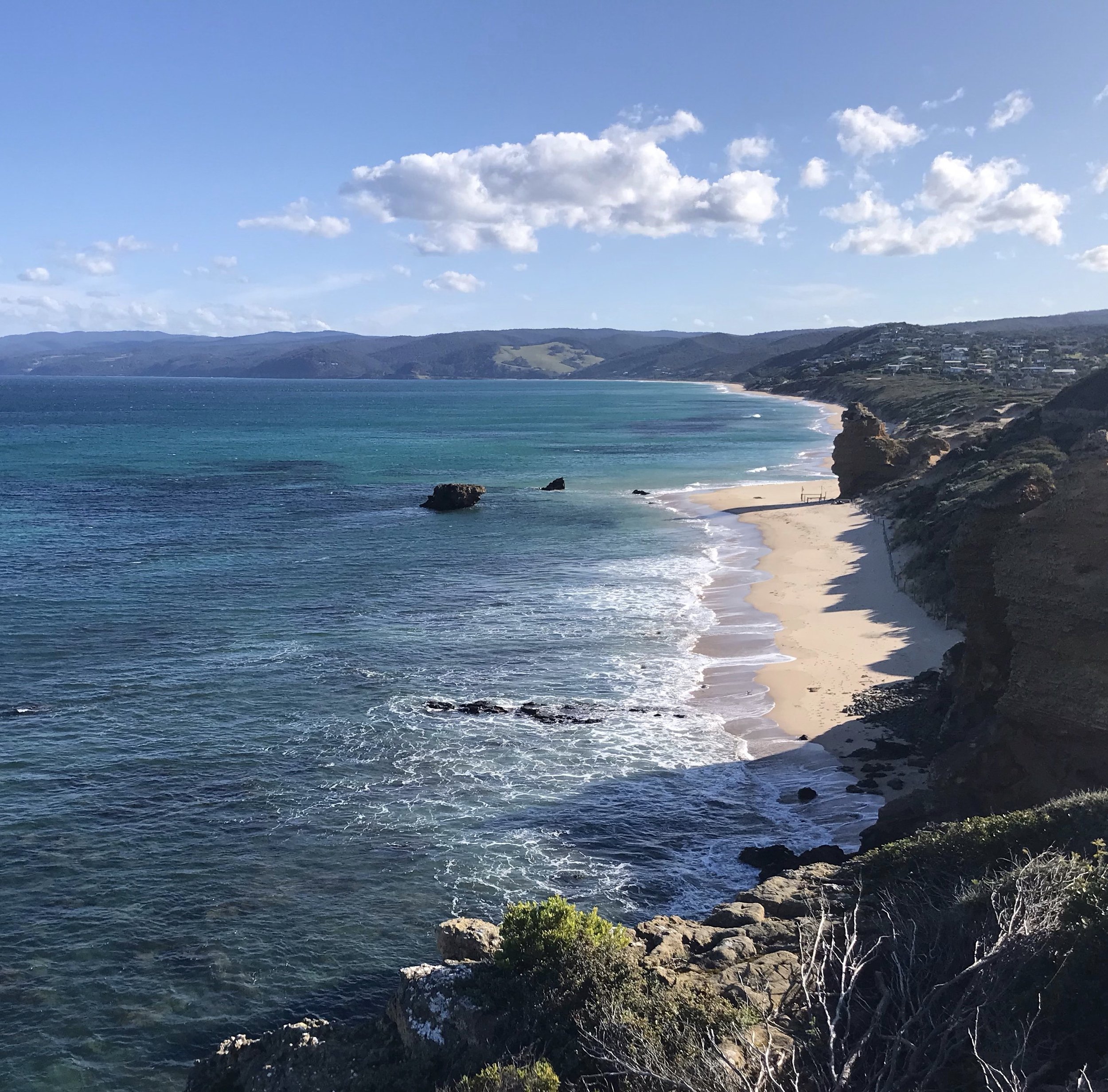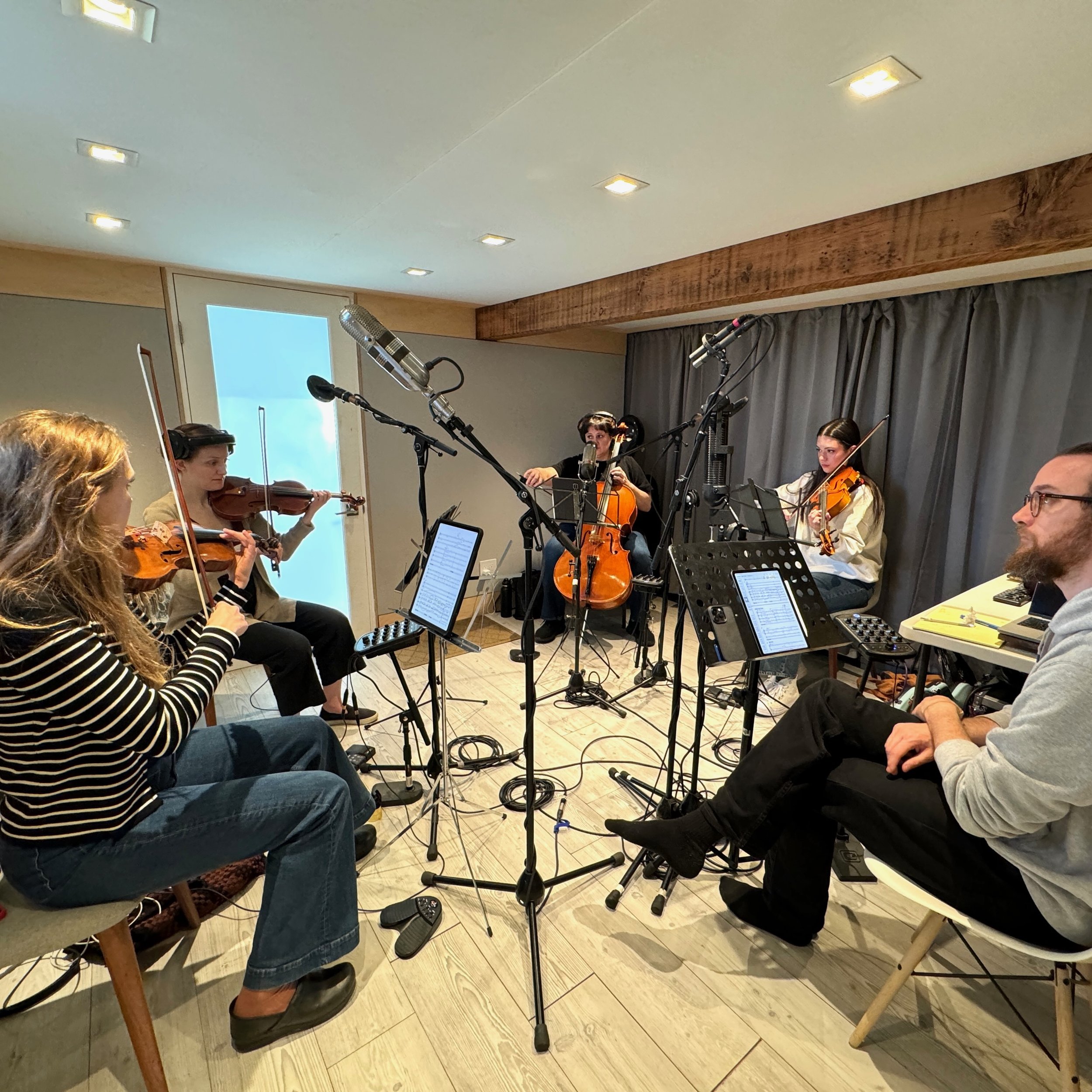Alto saxophonist and composer Jonathon Crompton presents his sophomore release, Cantata No. 1: An Island Seen and Felt.
A through-composed work in three movements, Cantata No. 1 sees Crompton synthesize his intimate knowledge of Renaissance counterpoint and classical composition with his background in jazz improvisation, in order to paint a portrait of the coastline near his boyhood home in Australia, displayed in the site's banner, above. This studio recording of the work, painstakingly tracked and mixed at Greyfade Studio by GRAMMY-winning Joseph Branciforte, features a cast of characters from New York's classical, early music, and improvised music scenes.
Aine Hakamatsuka, soprano
Rachel Mikol, soprano
Kate Goddard, violin
Masha Polishchuk, violin
Kiley Rowe, viola
Maria Jeffers, cello
Jonathon Crompton, alto saxophone
James Wengrow, electric guitar
Recorded on the 12th, 17th, 18th, 19th, and 31st of March, 2024 by Joseph Branciforte at Greyfade Studio, NY. Mixed and Mastered by Joseph Branciforte at Greyfade Studios, NY.

This recording is supported by the Australian Federal Government through Creative Australia.
Mary Cary Hall, Sept 9, 2023
While not to be confused with the studio-recorded version of the cantata, the premiere, presented below, is representative of the work, and was described by writer Elijah Shiffer (New York Jazz Record, JazzRightNow.com) as containing "immersive soundscapes with an instrumentation full of melody" performed by "an extremely tight ensemble, with nothing rough anywhere around the edges."

Alto saxophonist, composer, and scholar Jonathon Crompton presents Cantata No. 1: An Island Seen and Felt.
Born and raised in Australia and currently based in New York City, Crompton has developed an expansive musical vision that is as inspired by fellow altoists Henry Threadgill and Anthony Braxton as it is by his immersive study of Renaissance counterpoint. Through his series of Australian Landscape Cantatas, however, of which Cantata No. 1: An Island Seen and Felt is the first, Crompton hones these diverse influences into a series of focused portraits that celebrate his homeland. Cantata No. 1 is a vignette centered on Australia's beaches. It was premiered in New York in Fall 2023 with support from the Australia Council of the Arts, and was hailed by writer Elijah Shiffer (the New York City Jazz Record, JazzRightNow.com) as "a satisfyingly exquisite experience … infused with a strong sense of wonder, a reverence for the beauty of both music and nature."
While Crompton's fearless refusal to compromise on his transhistorical, polystylistic vision has already been recognized by critics as "a melding of disparate traditions into something distinctive and compelling" (All About Jazz), Cantata No. 1 is Crompton's first work to explicitly harness his intensive five-year study of historical composition and counterpoint in sixteenth-century sacred style, and thus heralds a distinct evolution of his compositional practice. Scored for two sopranos, alto saxophone, string quartet, and electric guitar, the 45-minute piece is Crompton's most ambitious chamber work to date. The cantata was developed between the spring of 2022 through the summer of 2023, as Crompton first experimented with various instrumental combinations before settling on ambient electric guitar and string quartet writing based on composers like Ravel, Debussy, and Janácek—all the while continually revising his contrapuntal writing and exploring how best to integrate it into the lush guitar and the "impressionism"-inspired string textures he was hearing. Ultimately, the project aims to synthesize and unite these discrete cultural and historical music elements on the one hand, and on the other, through this synthesis, to capture something of the remote, elemental power of the Australian coastal landscape.

AUSTRALIAN ROOTS
The title of this first cantata is taken from Australian author Tim Winton's 2015 memoir Island Home, in which he conveys a sentiment that is the central thrust of the cantata series: "Landscape has exerted a kind of force upon me which is every bit as geological as family. Like many Australians, I feel this tectonic grind—call it a familial ache—most keenly when abroad." The cantata thus thematizes displacement, homesickness, the joy and revelry of cherished memories, and nostalgia for place, via reflections upon Crompton's childhood in Victoria's Surf Coast. The Surf Coast is represented explicitly in the music itself: the contrapuntal activity of the vocals, embroidered by the more ornate melodies of the saxophone, evokes the restless waves, while the slow harmonic changes under the music's surface suggests tides. Generally, the keys are minor, imparting nostalgia and longing to the music. The strings either recall child-like play and excitement, or they match the vocals in their austerity and piety, with an added vulnerability. In contrast to the vocal lines, whose other-worldly and crystalline presence convey the spiritual experience of swimming in those waters, the guitar's and saxophone's improvised elements provide something perhaps more rough, more emblematic of the quintessential Australian wildness.
Winton has a further thematic claim in Cantata No. 1: his novel That Eye, The Sky depicts a spiritual presence both subliminally, via his descriptions of the Australian landscape, and explicitly, through the evocation of the sky itself as a watchful, mute deity. Towards a spiritual presence in the cantata, in addition to sacred-style polyphony as an other-worldly 'presence,' is its text: selected stanzas of Psalm 18, which celebrates the infinitude of the day, night, and the sky.

CANTATAS
Cantatas are a genre developed in the Christian church of Western Europe and dating roughly from the seventeenth century. While many books have been written concerning them, they can be reduced to four central characteristics—on account of which Crompton felt they were appropriate conceptual models for his own work in developing An Island Seen and Felt. First, in our own time, cantatas carry residual spiritual connotations from their once-central role in church services; swimming in Australia’s beaches remains a profoundly spiritual experience to Crompton. Second, cantatas usually had a plot, image, or narrative, suiting Crompton’s programmatic bent here. Third, they included singing and instruments during a time when instruments in European churches were quite novel—indeed, cantatas were something of an eclectic, technicolor, multimedia extravaganza for Baroque church goers, and Crompton certainly harnesses eclecticism in this first cantata. Finally, cantatas tended to be multi-movement works, with each movement having a discrete character and affect, an attribute that Crompton very much taps into in Cantata No. 1.
A GROUP EFFORT
As a large-scale chamber work, the realization of Cantata No. 1 would obviously not have been musically or logistically possible for Crompton on his own. And while Crompton is deeply honored to have worked with all involved in the project, the work's recording commemorates, and stands as a testament to, his relationships with three artists in particular—who he counts as his oldest friends in the United States and with whom he enjoys especially creative and trusting collaborations. Among the musicians on the record, Crompton is joined by long-time collaborator Australian guitarist James Wengrow, who also joined him in the premiere; they each moved to New York City to study improvisation and jazz in the fall of 2013 and have collaborated frequently ever since. Their musical kinship is audible in the cohesion and near-telepathic flow of their improvised duet passages that structure the cantata's first movement. Similarly, almost as soon as Crompton arrived in New York, he befriended violinist Kate Goddard, mainstay of the New York freelance string scene, who led the string quartet through the cantata's development and premiere and leads it in this recording. Having known Crompton and his influences for over a decade by the time of Cantata No. 1, from their first rehearsal Goddard understood how to direct the string quartet through the almost pop-inspired interjections of the first movement, the virtuosic, nineteenth-century part writing of the second, and the blurry symphonic wash of the third.
Aside from those who perform on the recording, another of Crompton’s friends has left an important and indelible mark on the cantata: GRAMMY-winning sound engineer Joseph Branciforte. While this is not the first of Crompton’s recordings to have benefitted from Branciforte’s considerable skill and taste (that title falls to a Crompton-Wengrow collaboration, Faustian Pact, in 2017), Cantata No. 1 saw the pair working more intensely and closely than ever before. As with Wengrow and Goddard, Branciforte has known Crompton and been involved with Cantata No. 1 for some time. He recorded, mixed and mastered Crompton’s first release as leader, Intuit, in 2019, produced the live sound of the Cantata No. 1's premiere, and conducted the live tracking for the premiere’s release on film. It would not be an understatement if, along with Crompton, Branciforte should be listed as “producer” for the studio iteration of the cantata: the work was recorded at his recording studio, Greyfade Studio, across five days in March of 2024, and was mixed and mastered during that summer over a further five days, in an intensely dialogical and collaborative process.
Cantata No. 1: An Island Seen and Felt thus marks the culmination of Crompton’s output—technically, musically, artistically, and collaboratively.



